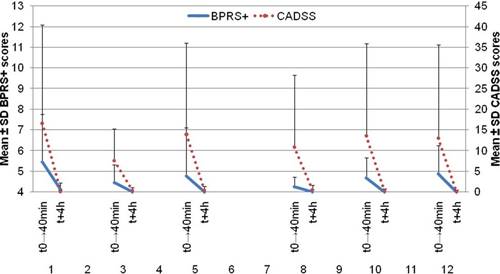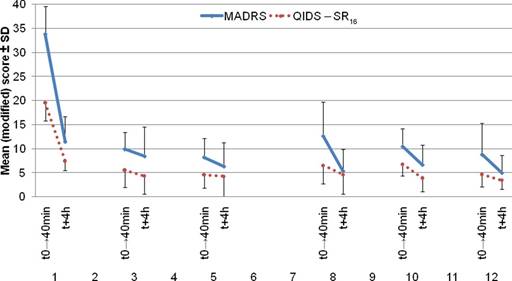- Green SM, Li J (2000): Ketamine in adults: What emergency physicians need to know about patient selection and emergence reactions. Acad Emerg Med 7:278 –281.
- Krystal JH, D’Souza DC, Karper LP, Bennett A, Abi-Dargham A, AbiSaab D, et al. (1999): Interactive effects of subanesthetic ketamine and haloperidol in healthy humans. Psychopharmacology 145:193– 204.
- Krystal JH, Madonick S, Perry E, Gueorguieva R, Brush L, Wray Y, et al. (2006): Potentiation of low dose ketamine effects by naltrexone: Potential implications for the pharmacotherapy of alcoholism. Neuropsychopharmacology 31:1793–1800.
- Javitt DC (2007): Glutamate and schizophrenia: Phencyclidine, N-methyld-aspartate receptors, and dopamine– glutamate interactions. Int Rev Neurobiol 78:69 –108.
- Berman RM, Cappiello A, Anand A, Oren DA, Heninger GR, Charney DS, Krystal JH (2000): Antidepressant effects of ketamine in depressed patients. Biol Psychiatry 47:351–354.
- Zarate CA Jr, Singh JB, Carlson PJ, Brutsche NE, Ameli R, Luckenbaugh DA, et al. (2006): A randomized trial of an N-methyl-D-aspartate antagonist in treatment-resistant major depression. Arch Gen Psychiatry 63: 856 – 864.
- First MB, Spitzer RL, Gibbon M, Williams JBW (2001): Structured Clinical Interview for DSM-IV TR Axis I Disorders, Research Version, Patient Edition (SCID-I/P). New York: New York State Psychiatric Institute, Biometrics Research.
- Sackeim HA (2001): The definition and meaning of treatment-resistant depression. J Clin Psychiatry 62(suppl 16):10 –17.
- Mathew SJ, Murrough JW, aan het Rot M, Collins KA, Reich DL, Charney DS (2009): Riluzole for relapse prevention following intravenous ketamine in treatment-resistant depression: A pilot randomized, placebocontrolled continuation trial [published online ahead of print March 17]. Int J Neuropsychopharmacol. doi:10.1017/S1461145709000169.
- Rush AJ, Carmody TJ, Ibrahim HM, Trivedi MH, Biggs MM, ShoresWilson K, et al. (2006): Comparison of self-report and clinician ratings on two inventories of depressive symptomatology. Psychiatr Serv 57:829 – 837.
- Price RB, Nock MK, Charney DS, Mathew SJ (2009): Effects of intravenous ketamine on explicit and implicit measures of suicidality in treatmentresistant depression. Biol Psychiatry 66:522–526.
- Overall JE, Gorham DR (1962): The Brief Psychiatric Rating Scale. Psychol Rep 10:799 – 812.
- Bremner JD, Krystal JH, Putnam FW, Southwick SM, Marmar C, Charney DS, et al. (1998): Measurement of dissociative states with the clinicianadministered dissociative states scale (CADSS). J Trauma Stress 11: 125–136.
- Levine J, Schooler NR (1986): SAFTEE: A technique for the systematic assessment of side effects in clinical trials. Psychopharmacol Bull 22:343– 381.
- Montgomery SA, Asberg M (1979): A new depression scale designed to be sensitive to change. Br J Psychiatry 134:382–389.
- Lenderking WR, Hu M, Tennen H, Cappelleri JC, Petrie CD, Rush AJ (2008): Daily process methodologyfor measuring earlier antidepressant response. Contemp Clin Trials 29:867– 877.
- Duncan EJ, Madonick SH, Parwani A, Angrist B, Rajan R, Chakravorty S, et al. (2001): Clinical and sensorimotor gating effects of ketamine in normals. Neuropsychopharmacology 25:72– 83.
- Lahti AC, Warfel D, Michaelidis T, Weiler MA, Frey K, Tamminga CA (2001): Long-term outcome of patients who receive ketamine during research. Biol Psychiatry 49:869 – 875.
- Goldberg ME, Domsky R, Scaringe D, Hirsh R, Dotson J, Sharaf I, et al. (2005): Multi-day low dose ketamine infusion for the treatment of complex regional pain syndrome. Pain Physician 8:175–179.
- Mills IH, Park GR, Manara AR, Merriman RJ (1998): Treatment of compulsive behaviour in eating disorders with intermittent ketamine infusions. Q J Med 91:493–503.
- Tsai GE (2007): Searching for rational anti N-methyl-D-aspartate treatment for depression. Arch Gen Psychiatry 64:1099 –1100.
- Correll GE, Futter GE (2006): Two case studies of patients with major depressive disorder given low-dose (subanesthetic) ketamine infusions. Pain Med 7:92–95.
- Sackeim HA, Haskett RF, Mulsant BH, Thase ME, Mann JJ, Pettinati HM, et al. (2001): Continuation pharmacotherapy in the prevention of relapse following electroconvulsive therapy: A randomized controlled trial. JAMA 285:1299 –1307.
- Kellner CH, Knapp RG, Petrides G, Rummans TA, Husain MM, Rasmussen K, et al. (2006): Continuation electroconvulsive therapy vs pharmacotherapy for relapse prevention in major depression: A multisite study from the Consortium for Research in electroconvulsive therapy (CORE). Arch Gen Psychiatry 63:1337–1344.


